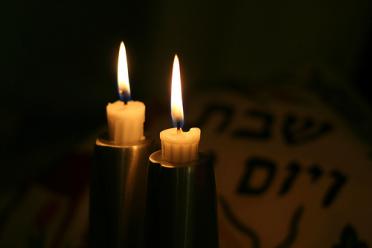Every week, parshaoftheweek.com brings you a rich selection of material on parshat hashavua, the weekly portion traditionally read in synagogues all over the world. Using both classic and contemporary material, we take a look at these portions in a fresh way, relating them to both ancient Jewish concerns as well as cutting-edge modern issues and topics. We also bring you material on the Jewish holidays, as well as insights into life cycle rituals and events...
Parshat Ki Tisa continues the topic of the Mishkan, the tabernacle, the portable temple used by the Israelites in the desert, which we've been discussuing for the last few portions. After giving us the law of the half shekel, donated yearly to the temple by every Jew to pay for the communal sacrifices, the parsha goes on to talk about a number of items which are needed in the tabernacle; a sink, oil for annointing all the utensils and the priests, and incense to be burnt. The long multi-parsha section on the construction of the Mishkan ends with the naming of the chief artisans who are in charge of the project, Bezalel and Oholiav.
At this stage, all the basic instructions for the Tabernacle have been given. What happens next is this: God tells Moshe to tell the Jewish people אך את שבתותי תשמרו כי אות היא ביני וביניכם לדורותיכם לדעת כי אני ה' מקדשכם - "However, my Sabbaths you must keep, for it is a sign between Me and you all for your generations, to know that I am the Lord who sanctifies you." The Torah goes on to explain that the Sabbath signifies that the world was created by God in six days, and that he rested on the seventh. Our resting echoes, commemorates, and testifies to this belief.
The Rabbis understand this as a commandment to specifically NOT build the Tabernacele on Shabbat. Follow all the instructions, gather all the neccessary materials, get the artisans together, build it, but not on the Sabbath. In fact, this becomes the seminal definition of what is prohibited on the Sabbath - by figuring out exactly what work went into buliding the mishkan, the Rabbis define what is forbidden work on Shabbat. The building of the Tabernacle defines what Shabbat is - Sabbath is the day you don't build the Temple, the day you refrain from all the activities neccessary to build a Temple.
On the one hand, this is a beautiful definition of what work is. In its purest, absolute form, work is our attempt to create something holy, to build a place that houses that which is divine, sacred, trancendent. That is, ultimately, what we work towards, what we try to create in this world. On the other hand, the sanctity of the Sabbath seems to be the exact opposite of that effort. It is a refraining from the building of a holy space, the holy non-act of NOT creating sanctity. How are we to understand these apparently contradictory types of holiness; that of the temple, which we build during the working week, and that of Shabbat, which we create by NOT building the temple? And why does the latter holiness, that which is created by a sacred act of refraining, trump the holiness of building the mishkan? Why is the non-act greater, apparently, than the act?
The Torah does explain why Shabbat's inactivity trumps the tabernacle's holy busy-ness: "for it is a sign between me and all of you for your generations, to know that I am the Lord who sanctifies you." The Torah seems to be saying that Shabbat has elements which are missing in a temple, which explain its primacy over the temple. These elements would seem to be the ongoing, multi-generational nature of the Shabbat, as opposed to the specific historicity of the temple. The temple, as this week's parsha tells us, is something that needs to be built, by specific people, with specific materials, in a specific way. The temple exists in time and space, is an expression of time and space. At one time and in one place it is a portable tabernacle in the desert. Later, it is the grand temple of Solomon, of Ezra and Nechemia, and later, the grandest of all, of Herod, in Jerusalem. The temple moves, is built, is destroyed, rebuilt, fought over, and destroyed again. It exists in a series of specific physical realities. Shabbat, on the other hand, is an idea, a sign, a multi-generational reality, embedded in creation itself, standing forever and everywhere as a testimony to that creation. It is part of nature - in the very creation of the universe - part of the Jewish people's deeply embedded reality, located neither in space nor time, but in eternity.
The primacy of Shabbat, and its holiness, over the sanctity of the tabenacle and temple, is the primacy of the idea over its application, the thought over the deed. By priveleging the Sabbath over the temple, we proclaim that our real alleigance is not to bricks and mortar, animal skins and precious metals, but to concepts, ideas and ideals. We understand that an idea, once made into reality, has a shelf-life, can easily become outmoded, irrelevant, prone to decay and corruption. The idea itself, however, is free of the fetters of the physical. It can soar, evolve naturally, transform itself. It resists the decline to which the physical is naturally subject.
The idea of the Sabbath is the central idea of Judaism: the existence of a Creator, and His covenental relationship with the Jewish people. The temple, a physical expression of that idea, invites bribery, power politics, conquest, greed. Unlike even the holiest of buildings, an idea, in its lack of physicality, its lack of specific physical content, can never be conquered, never be destroyed, never be taken over. The Shabbat, the idea of our covenant with God the Creator, is our ultimate Holy Place.
Shabbat Shalom,
Rabbi Shimon Felix



Get inspired by Ki Tisa Divrei Torah from previous years